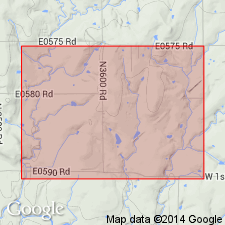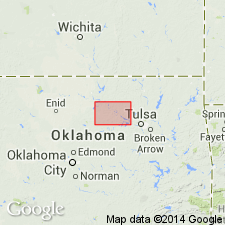
- Usage in publication:
-
- [Hallett shale. Possibly also called Hallett formation in this report.]
- Modifications:
-
- Original reference
- Dominant lithology:
-
- Shale
- AAPG geologic province:
-
- Chautauqua platform
Summary:
Pg. 122-125. [Hallett shale. Possibly also called Hallett formation in this report.] Name given to predominantly shale sequence from top of Bird Creek limestone to base of Wakarusa limestone. Thickness about 105 feet. Age is Pennsylvanian (Virgilian). Name credited to P.B. Greig (unpub. thesis).
Type section: exposed south of village of Hallett, Pawnee Co., northeastern OK.
Source: US geologic names lexicon (USGS Bull. 1200, p. 1649).

- Usage in publication:
-
- Hallett shale
- Modifications:
-
- Original reference
- Dominant lithology:
-
- Shale
- AAPG geologic province:
-
- Chautauqua platform
Summary:
Pg. 50-53, pl. 1. Hallett shale of Wabaunsee group. Thickness 105 to 110 feet. Overlies Bird Creek limestone; underlies Wakarusa limestone. Equivalent section in Kansas contains nine subdivisions, none of which can be identified in Pawnee County. In Wabaunsee group. Age is Late Pennsylvanian (Virgilian).
Type section: exposed south of village of Hallett, Pawnee Co., northeastern OK.
Source: US geologic names lexicon (USGS Bull. 1200, p. 1649).
For more information, please contact Nancy Stamm, Geologic Names Committee Secretary.
Asterisk (*) indicates published by U.S. Geological Survey authors.
"No current usage" (†) implies that a name has been abandoned or has fallen into disuse. Former usage and, if known, replacement name given in parentheses ( ).
Slash (/) indicates name conflicts with nomenclatural guidelines (CSN, 1933; ACSN, 1961, 1970; NACSN, 1983, 2005, 2021). May be explained within brackets ([ ]).

